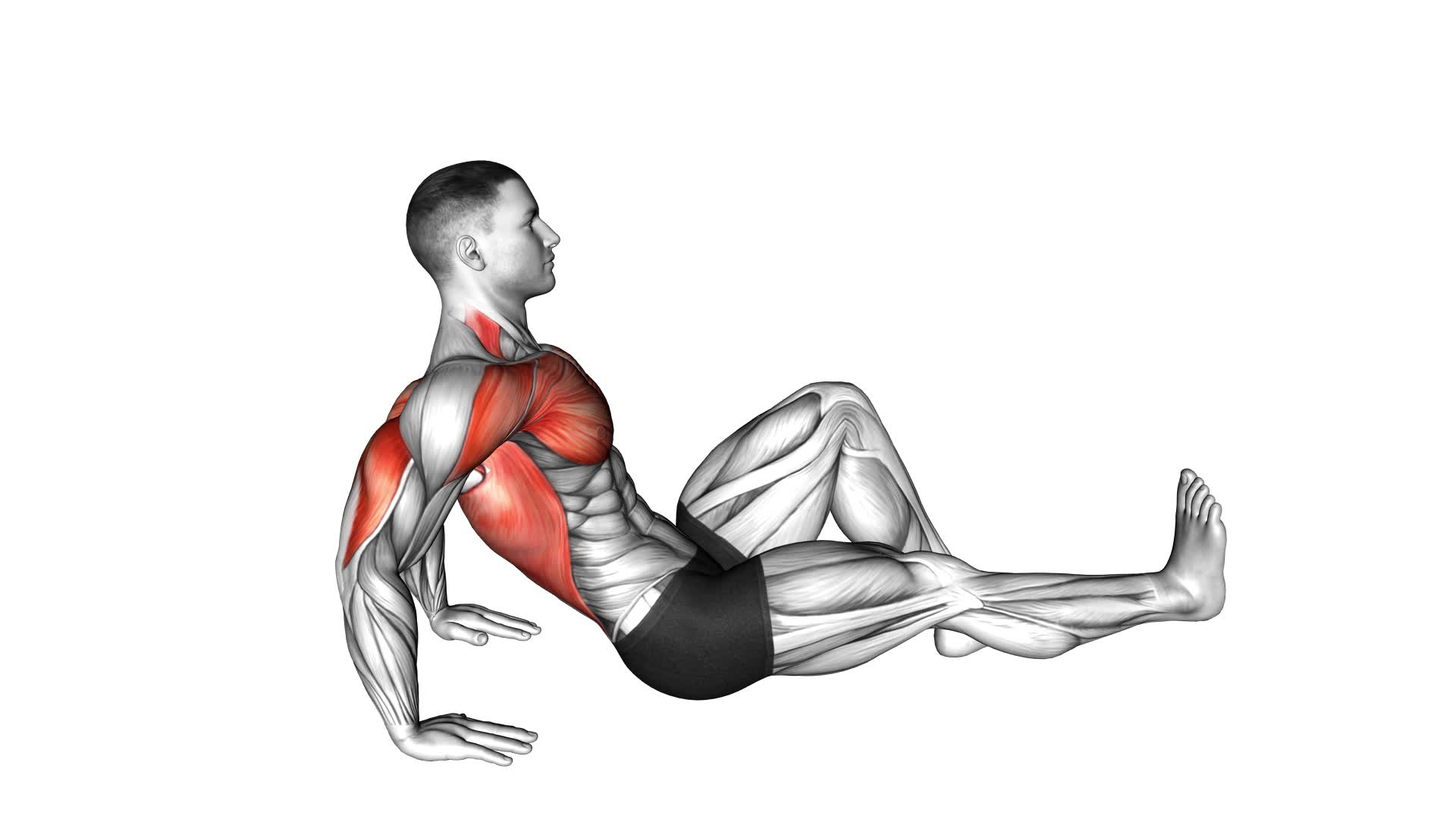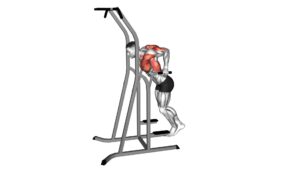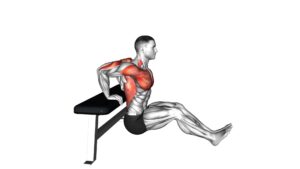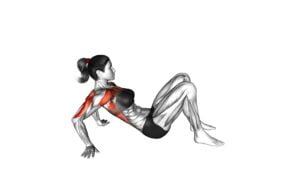Single Leg Dip on Floor – Video Exercise Guide & Tips

Are you looking to strengthen your legs and improve your balance? Look no further than the single leg dip on the floor.
Watch This Exercise Video
This exercise targets your quadriceps, hamstrings, and glutes while also engaging your core.
With proper form and technique, you can avoid common mistakes and make progress towards your fitness goals.
In this article, we'll provide you with a video exercise guide and helpful tips to ensure you get the most out of your single leg dip workout.
Let's get started!
Key Takeaways
- Single leg dips target the quadriceps, hamstrings, and glutes, improving leg strength and endurance.
- Proper form and technique, such as keeping the knee in line with the ankle and engaging the core, are crucial to prevent strain and injury.
- Maintaining proper knee alignment, avoiding collapsing knees inward or outward, and engaging the core can help support the knees and reduce the risk of injury.
- Modifications and progressions, such as elevating the back leg or incorporating resistance bands, can be used to increase the challenge and effectiveness of single leg dips.
Benefits of Single Leg Dip
One benefit of performing the single leg dip exercise is that it strengthens your leg muscles. This exercise specifically targets your quadriceps, hamstrings, and calves, helping to improve their overall strength and endurance. By engaging these muscles, you can enhance your lower body stability and balance.
Additionally, the single leg dip exercise is highly effective in strengthening your glutes. As you lower your body down, your gluteal muscles are activated to stabilize your hip joint and support your body weight. This not only helps to tone and firm your glutes but also improves their overall strength and functionality. Strong glutes are essential for proper posture, hip stability, and efficient movement patterns.
Proper Form and Technique
When performing the single leg dip on the floor, it's important to pay attention to proper form and technique. By avoiding common mistakes such as leaning too far forward or allowing the knee to collapse inward, you can ensure that you're getting the most out of this exercise.
Common Mistakes to Avoid
To ensure proper form and technique during the single leg dip on the floor exercise, you should frequently check for these common mistakes:
- Allowing your knee to go past your toes: This puts unnecessary strain on your knee joint and increases the risk of injury. Make sure to keep your knee in line with your ankle throughout the movement.
- Leaning too far forward: This can cause your lower back to round and put excessive stress on your spine. Keep your torso upright and engage your core to maintain proper alignment.
- Neglecting to engage your glutes: By actively squeezing your glutes at the top of the movement, you maximize the benefits of the exercise and help stabilize your hips.
Benefits of Proper Form
By maintaining proper form and technique during the single leg dip on the floor exercise, you can experience a range of benefits for your muscles and overall stability.
Proper alignment is crucial in this exercise as it helps to target the intended muscles effectively and prevent strain or injury. When you maintain proper alignment, you ensure that your knees are in line with your toes and your back is straight throughout the movement.
This helps to activate the muscles in your glutes, hamstrings, and quadriceps, resulting in increased strength and endurance. Additionally, proper form promotes overall stability by engaging your core muscles and improving balance.
Common Mistakes to Avoid
Avoiding common mistakes is essential when performing the single leg dip on the floor exercise. Proper technique is crucial to ensure that you get the most out of this exercise while minimizing the risk of injury. Here are three common mistakes to avoid:
- Leaning too far forward: One of the most common mistakes is leaning too far forward during the single leg dip. This not only puts excessive strain on your knees but also reduces the effectiveness of the exercise. Make sure to keep your torso upright and engage your core muscles to maintain stability.
- Not lowering your hips enough: Another mistake isn't lowering your hips enough during the dip. To fully engage your leg muscles, make sure to lower your hips as close to the floor as possible without touching it. This will help you strengthen your thighs, glutes, and core effectively.
- Lifting your heel off the ground: Lifting your heel off the ground during the exercise can lead to instability and increase the risk of injury. Keep your entire foot flat on the floor throughout the movement to maintain balance and engage the muscles properly.
Modifications and Progressions
To continue building on your previous progress and challenge yourself further, there are several modifications and progressions you can incorporate into the single leg dip on the floor exercise.
For those looking for more advanced modifications, you can try elevating your back leg on a step or bench. This will increase the difficulty and further engage your glutes and hamstrings.
Another way to progress the exercise is by incorporating equipment. Using a resistance band around your thighs can provide extra resistance, making the exercise more challenging. This will help to strengthen your hip muscles and improve stability.
Additionally, you can try performing the single leg dip on an unstable surface, such as a balance disc or Bosu ball. This will require more core activation and balance, further enhancing the effectiveness of the exercise.
Remember to always listen to your body and progress at a pace that feels comfortable for you. It's important to maintain proper form and technique throughout the exercise to avoid any unnecessary strain or injury.
Safety Precautions and Considerations
When performing the single leg dip on the floor, it's crucial to maintain proper form to avoid injury. This exercise puts strain on the knees, so it's important to listen to your body and avoid excessive strain.
If you're a beginner, it's recommended to start with modifications such as using a support or reducing the range of motion to gradually build strength and stability.
Proper Form Importance
You should focus on maintaining proper form to ensure safety and prevent injuries during the Single Leg Dip on Floor exercise. Proper form is crucial for the effectiveness of the exercise and to minimize the risk of strain or injury. Here are some important considerations:
- Importance of alignment: Make sure your body is properly aligned throughout the exercise. Keep your shoulders back, chest lifted, and spine neutral. This will help to engage the correct muscles and avoid unnecessary strain on other areas of your body.
- Correct muscle activation: Focus on activating the muscles you're targeting, specifically the glutes and hamstrings. Avoid relying on other muscles to perform the movement, as this can lead to imbalances and potential injuries.
- Breathing and control: Breathe deeply and maintain control throughout the exercise. Avoid jerky or sudden movements, as this can put unnecessary stress on your joints.
By maintaining proper form, you can maximize the benefits of the Single Leg Dip on Floor exercise while minimizing the risk of injury.
Now, let's discuss how to avoid excessive knee strain.
Avoiding Excessive Knee Strain
To avoid excessive knee strain during the Single Leg Dip on Floor exercise, it's crucial to pay attention to your knee alignment and maintain proper form throughout the movement. Improper alignment can put unnecessary stress on your knees and increase the risk of injury. Make sure your knee stays in line with your toes and doesn't collapse inward or outward.
Additionally, keep your core engaged and your back straight to support your knees. If you have a history of knee problems or want to prevent knee injuries, it may be beneficial to consult with a healthcare professional or a certified trainer for alternative exercises that focus on knee health. These exercises can help strengthen the muscles around the knee and improve stability, reducing the risk of injury.
Modifications for Beginners
Maintain proper knee alignment and form to avoid excessive strain and reduce the risk of injury during the Single Leg Dip on Floor exercise, especially if you're a beginner. Here are some modifications and alternative exercises to consider:
- Use a support: Hold onto a stable surface, such as a chair or countertop, for added balance and support during the exercise.
- Decrease range of motion: Start with a smaller dip, only lowering your body a few inches, until you build strength and confidence.
- Perform assisted dips: Use a resistance band or a partner to assist you in completing the exercise, making it easier on your muscles and joints.
Remember, it's important to listen to your body and progress at your own pace. As you become more comfortable and stronger, you can gradually increase the difficulty of the exercise.
Now, let's move on to a sample single leg dip workout routine.
Sample Single Leg Dip Workout Routine
A sample single leg dip workout routine can enhance your lower body strength and stability. By incorporating different variations of the single leg dip exercise into your routine, you can target various muscles in your legs, glutes, and core.
One variation is the elevated single leg dip, where you place your foot on an elevated surface, such as a step or bench, to increase the range of motion and challenge your muscles even more.
Another variation is the weighted single leg dip, where you hold a dumbbell or kettlebell in one hand while performing the exercise, adding resistance and increasing the intensity. These variations not only provide a greater challenge but also help improve balance and coordination.
The benefits of including single leg dips in your workout routine are numerous. They help strengthen your quadriceps, hamstrings, glutes, and calves, improving overall leg strength. Additionally, they engage your core muscles, helping to stabilize your body during the exercise.
Frequently Asked Questions
How Many Calories Does the Single Leg Dip Exercise Burn?
The single leg dip exercise can help you burn calories and provide numerous benefits. By targeting your lower body muscles, such as your quads, hamstrings, and glutes, this exercise can increase your heart rate and improve your strength and stability.
While the exact number of calories burned may vary depending on factors like intensity and duration, incorporating single leg dips into your fitness routine can contribute to your overall calorie burn and help you achieve your weight loss goals.
Can Single Leg Dips Help Improve Balance and Stability?
Single leg dips are a great exercise for improving balance and stability. By targeting the muscles in your legs and core, they help strengthen the muscles responsible for maintaining balance.
Additionally, single leg dips can also help improve flexibility, as they require a full range of motion in your hips and knees.
There are various variations of single leg dips that you can try to further challenge your balance and stability, such as using a stability ball or adding weights.
Should I Use Weights While Performing Single Leg Dips?
When performing single leg dips, it can be beneficial to use resistance bands for added resistance. This can help increase the intensity of the exercise and challenge your muscles even more.
Additionally, doing single leg dips on a stability ball can further enhance the benefits by engaging your core and improving balance and stability.
However, it's important to start with bodyweight exercises before adding weights or using stability balls to ensure proper form and prevent injury.
Can Single Leg Dips Help Alleviate Knee Pain?
Single leg dips can be a helpful exercise for alleviating knee pain. By strengthening the muscles around the knee joint, such as the quadriceps and glutes, single leg dips can provide stability and support to the knees.
However, it's important to perform the exercise with proper form to avoid putting excessive stress on the knees.
There are variations of the single leg dip that can be used to target different muscle groups and add variety to your workout routine.
How Often Should I Incorporate Single Leg Dips Into My Workout Routine for Optimal Results?
To achieve optimal results, it's important to incorporate single leg dips into your workout routine with the right frequency. Varying the types of single leg dips can also enhance your progress.
However, it's essential to consult with a fitness professional to determine how often you should perform this exercise based on your goals and current fitness level.
Remember to listen to your body and make adjustments as needed to prevent any potential injuries.
Conclusion
In conclusion, the single leg dip is a beneficial exercise that can help improve lower body strength and stability. By maintaining proper form and technique, avoiding common mistakes, and gradually progressing the difficulty level, individuals can maximize the benefits of this exercise.
However, it's important to prioritize safety and consult with a professional if you have any concerns or underlying health conditions. Incorporating the single leg dip into a well-rounded workout routine can contribute to overall fitness and performance.

Author
Years ago, the spark of my life’s passion ignited in my mind the moment I stepped into the local gym for the first time. The inaugural bead of perspiration, the initial endeavor, the very first surge of endorphins, and a sense of pride that washed over me post-workout marked the beginning of my deep-seated interest in strength sports, fitness, and sports nutrition. This very curiosity blossomed rapidly into a profound fascination, propelling me to earn a Master’s degree in Physical Education from the Academy of Physical Education in Krakow, followed by a Sports Manager diploma from the Jagiellonian University. My journey of growth led me to gain more specialized qualifications, such as being a certified personal trainer with a focus on sports dietetics, a lifeguard, and an instructor for wellness and corrective gymnastics. Theoretical knowledge paired seamlessly with practical experience, reinforcing my belief that the transformation of individuals under my guidance was also a reflection of my personal growth. This belief holds true even today. Each day, I strive to push the boundaries and explore new realms. These realms gently elevate me to greater heights. The unique combination of passion for my field and the continuous quest for growth fuels my drive to break new ground.



